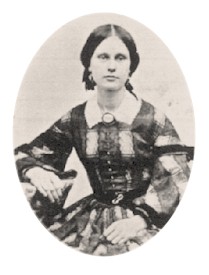Boys
had a defined "look" during the l860's era and by paying a little
attention to detail we can define and recreate it. For younger boys
shirts and pants often buttoned together, but this practice was dispensed
with as the boy grew. Hair was neatly parted on the side - a practice
that would not change as he aged. Shoes were square toed boots with flat
heel, and usually laced. White shirts were considered an undergarment,
therefore no well brought up young man appeared in public without a vest
or coat.

Our
first young lad wears shirt and pants of matching fabric which are
buttoned together at the waist. It is difficult to tell whether this is
cotton or wool fabric, but it has a pattern - a small check. Trim has
been applied down the legs of the pants, around the cuff of the pants, on
the shoulders, down the center front, and on the cuffs. He has a white
collar, and square toed boots. He appears to be holding a hat on his
knee. Hair is neatly parted on the side.

Our
second young fellow is a couple of years older, but we can see a button
showing where his pants and shirt are still buttoned together. He wears
pants and jacket of matching fabric with a decorative button closure, and
white shirt. His jacket has set-in pockets much as Father's might. Hair
is again neatly parted on the side, and the "look" is completed with
square-toed boots. He holds his hat in his hand for the photographer.

This
young man has outgrown the practice of buttoning pants and shirt together.
He wears striped pants, white shirt, and dark jacket. Hair is parted on
the side. Shoes are square-toed. His suit is accessorized by a bow tie
at the neck.

This young man
is dressed very much as his father or older brother would have. He has
pants and frock coat which either match or are close in color and
texture. His vest or waistcoat is of different but harmonizing fabric,
and the pattern is a small check, as opposed to the pants and coat which
appear to be solid. He has a white shirt accessorized by a bow tie.
This frock coat does not have a velvet collar as some do. Hair is
parted on the side and while we cannot see his feet his boots or shoes
would be the same style as his father would have worn. The fabrics used
here might have been wool, linen, or cotton, perhaps silk for the
waistcoat.

Master Matthew
Rumble shows that the "look" for young man is easily obtained through a
correct combination of fabric and cut. Image by Tim Parson, Carnton
Plantation June 2000.
While the images
do not show enough detail to notice it buttonholes on all boys' (and
girls') garments would have been hand-stitched. The technology for
machine stitched buttonholes had not been invented yet. This is an area
where compromise can make or break your best efforts to duplicate these
clothes. Hand-stitched buttonholes are simple and your Mentor will be
happy to assist you.
We can see the
stages of clothing for these young men evolve through this series of
images. A frock coat or sack coat would be appropriate for boys to
young men as well as adults, although the frock coat would have been
worn for more formal or dressy occasions.





